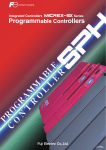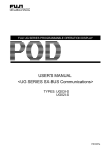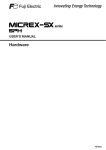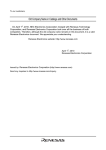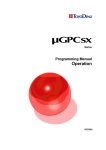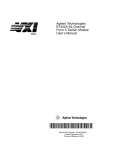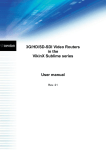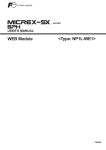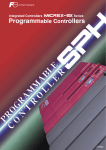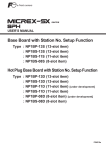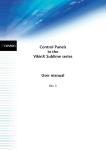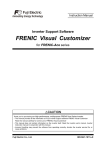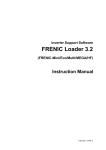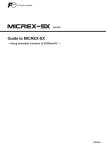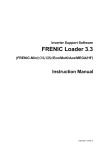Download Conformance with Standards
Transcript
series USER’S MANUAL Conformance with Standards FEH249 Preface Thank you very much for purchasing the FUJI MICREX-SX Series SPH. This users' manual describes operational instructions and restrictions on MICREX-SX Series products that conform to various standards (CE marking, Lloyd's Register of Shipping, etc.) Please read this manual carefully to correctly use your device. If your MICREX-SX Series product does not need to conform to CE marking or Lloyd's Register of Shipping, there is no need to execute the content of this manual. There will be no problem with performance and functionality. If your MICREX-SX Series product is required to conform to those standards, you must execute the content of this manual. Note that this manual deals with MICREX-SX Series products of "basic structure," and therefore additional measures may be necessary depending on the configuration of your system, the structure of the control panel, or the product's work environment. <Notes> 1. This manual may not be reproduced in whole or part in any form without prior written approval by the manufacturer. 2. The contents of this manual (including specifications) are subject to change without prior notice. 3. If you find any ambiguous or incorrect descriptions in this manual, please write then down (along with the manual No. Shown on the cover) and contact FUJI. Revision *Manual No. is shown on the cover. Printed on *Manual No. Revision contents May.2000 FEH249 First edition Contents Preface Revision Contents Section1 Standards Conformed Product 1-1 Standards conformed products list ...................................................................................... 1-1 Section2 Conformance with CE marking 2-1 CE marking ............................................................................................................................. 2-1 2-2 Method for adapting to CE marking ..................................................................................... 2-2 2-2-1 Metal Enclosure .............................................................................................................................. 2-2 2-2-2 How to lay the SX bus cable ............................................................................................................ 2-3 2-2-3 Adaptation of individual module ...................................................................................................... 2-4 (1)T-link master / interface module (NP1L-TL1/RT1) ............................................................................. 2-4 (2)OPCN-1 master module ( NP1L-JP1) .................................................................................................. 2-5 (3)FL-net ( OPCN-2 ) module ( NP1L-FL1 ) ............................................................................................. 2-5 (4)Precautions for using the "AS-i" master module ( NP1L-AS1 ) ............................................................ 2-6 (5)DeviceNet master module ( NP1L-DN1 ) ............................................................................................ 2-6 (6)Measures for the positioning modules ................................................................................................. 2-7 Seciton3 Adaptation to UL standard / Lloyd's Resister of Shipping / NK 3-1 Adaptation to UL standard .................................................................................................... 3-1 3-2 Adaptation to Lloyd's Resister of Sipping / NK .................................................................... 3-1 Section4 Installing the PC & Wiring of power supply 4-1 Installing PC units .................................................................................................................. 4-1 4-2 Wiring of power supply ......................................................................................................... 4-2 Section1 Standards Conformed Product 1-1 Standards conformed products list Component Type Specification CE UL cUL LR NK CPU module NP1PS-74 High-performance CPU module Program memory:74K steps yes no no no no NP1PS-32 High-performance CPU module Program memory:32K steps yes yes yes yes yes NP1PH-08 Standard CPU module Program memory:8K steps yes yes yes yes yes NP1PH-16 Standard CPU module Program memory:16K steps yes yes yes yes yes Power supply module NP1PS-22 100/200V AC yes yes yes yes yes NP1PS-42 24V DC yes yes yes yes yes Base board NP1BS-06 No.of slots:6 yes yes yes yes yes NP1BS-08 No.of slots:8 yes yes yes yes yes NP1BS-11 No.of slots:11 yes yes yes yes yes NP1BS-13 No.of slots:13 yes yes yes yes yes NP1BP-13 No.of slots:13 No.of processor buses:10 yes yes yes yes yes NP1C-P3 Cable length:30cm yes yes yes yes yes NP1C-P6 Cable length:60cm yes yes yes yes yes NP1C-P8 Cable length:80cm yes yes yes yes yes NP1C-02 Cable length:2m yes yes yes yes yes NP1C-05 Cable length:5m yes yes yes yes yes NP1C-10 Cable length:10m yes yes yes yes yes NP1C-25 Cable length:25m yes yes yes yes yes SX bus T-branch uint NP8B-TB For SX bus T-branch yes yes yes yes yes Digital input module NP1X1606-W 24V DC, 16 points yes yes yes yes yes NP1X3206-W 24V DC, 32 points yes yes yes yes yes NP1X3202-W 5/12V DC, 32 points yes yes yes yes yes NP1X3206-A 24V DC, 32 points High-speed counter 4 channels 20kHz yes yes yes no no NP1AX6406-W 24V DC, 64 points yes yes yes yes yes NP1X0810 100 to 120V AC, 8 points yes yes yes yes yes NP1X1610 100 to 120V AC, 16 points no no no yes yes NP1X0811 200 to 240V AC, 8 points yes yes yes yes yes NP1Y08T0902 Tr sink 12 to 24V DC, 8 points yes yes yes yes yes NP1Y16T09P6 Tr sink 12 to 24V DC, 16 points yes yes yes yes yes NP1Y32T09P1 Tr sink 12 to 24V DC, 32 points yes yes yes yes yes NP1Y64T09P1 Tr sink 12 to 24V DC, 64 points yes yes yes yes yes NPY32T09P1-A Tr sink 24V DC, 32 points Pulse train output function yes yes yes no no SX bus expansion cable Digital output module To adapt to CE marking, the measures described in 2-2-2 need to be taken. ( Continued on next page ) 1-1 Section1 Standards Conformed Product Component Type Specification CE UL cUL LR NK Digital output module NP1Y08U0902 Tr source 12 to 24V DC, 8 points yes yes yes yes yes NP1Y16U09P6 Tr source 12 to 24V DC, 16 points yes yes yes yes yes NP1Y32U09P1 Tr source 12 to 24V DC, 32 points yes yes yes yes yes NP1Y64U09P1 Tr source 12 to 24V DC, 64 points yes yes yes yes yes NP1Y06S Triac 100 to 200V AC, 6 points yes yes yes yes yes NP1Y08S Triac 100 to 200V AC, 8 points no no no yes yes NP1Y08R-04 Ry 110V DC,240V AC, 8 points yes yes yes yes yes NP1Y16R-08 Ry 110V DC,240V AC, 16 points no no no yes yes NP1W1606T input : sourse type24V DC, 8 points output : Tr sink12 to 24V DC, 8 points yes yes yes yes yes NP1W3206T input : source type24V DC, 16 points output : Tr sink12 to 24V DC, 16 points yes yes yes yes yes NP1W1606U input : sink type24V DC, 8 points output : Tr source12 to 24V DC, 8 points yes yes yes yes yes NP1W3206U input : sink type24V DC, 16 points output : Tr source12 to 24V DC, 16 points yes yes yes yes yes NP1AXH4-MR 4 channels, Resolution : 14bits yes yes yes yes yes NP1AX04-MR 4 channels, Resolution : 10bits yes yes yes yes yes NP1AX08-MR 8 channels, Resolution : 10bits yes yes yes no no Multi-range Analog output module NP1AYH2-MR 2 channels, Resolution : 10bits yes yes yes yes yes NP1AY02-MR 2 channels, Resolution : 10bits yes yes yes yes yes General purpose communication module NP1L-RS1 RS-232C : 1 channel, RS-485 : 1 channel yes yes yes yes yes NP1L-RS2 RS-232C : 1 channel yes yes yes yes yes NP1L-RS4 RS-485 : 1 channel yes yes yes yes yes FL-net ( OPCN-2 ) module NP1L-FL1 FL-net (OPCN-2 ) : 1 channel yes no no no no P-link module NP1L-PL1 P-link : 1channel no yes yes no no PE-link module NP1L-PE1 PE-link : 1 channel no yes yes no no OPCN-1 master module NP1L-JP1 OPCN-1 : 1 channel yes yes yes yes yes OPCN-1 interface module NP1L-RJ1 interface module to expansion OPCN-1 yes yes yes yes yes DeviceNet master module NP1L-DN1 DeviceNet : 1 channel yes no no no no AS-i master module NP1L-AS1 AS-i master : 1 channel yes no no no no T-link master module NP1L-TL1 T-link master : 1 channel yes yes yes yes yes T-link interface module NP1L-RT1 interface module to expansion T-link yes yes yes yes yes PC card interface module NP1F-PC2 General purpose PC card : 1 channel memory card : 1 channel yes no no no no Memory card interface module NP1F-MM1 SRAM memory card : 1 channel yes no no no no Digital input/output module Multi-range Analog input module ( Note ) To adapt to CE marking, the measures described in 22-3 need to be taken. ( Note )To adapt to CE marking, the measures described in 2-2-3 need to be taken. ( Continued on next page ) 1-2 Section1 Standards Conformed Product Component Type Specification CE UL Dummy module NP1F-DMY substitute for the failed module yes no no no no High-speed counter module NP1F-HC2 2 channels 500kHz yes no no no no NP1F-HC8 8 channels 50kHz yes no no no no Pulse train output module NP1F-HP2 Pulse train command, 2 channels 250kHz Forward pulse + reverse pulse yes no no no no Pulse train multiple module NP1F-MP2 Positioning control multiple module 2 axes, Pulse train command yes no no no no Analog multiplemodule NP1F-MA2 Positioning control multiple module 2 axes, Analog command yes no no no no Signal converter NP2F-LEV Convert signal level, From open collector signal to RS-485 or vice versa yes no no no no NP4H-CNV Personal computer cable for loader with converter yes yes yes yes yes NP4H-CA2 Personal computer cable for loader yes yes yes yes yes Simulative-input swich NP8X-SW 16 points yes yes yes yes yes Data backup battery NP8P-BT Lithium primary battery yes yes yes yes yes User ROM card NP8PMF-16 User ROM card 16k steps Dedicated to standard CPU yes yes yes yes yes CPU mode selection key swich NP8P-KY For CPU mode selection yes yes yes yes yes Base board mounting stud NP8P-ST For DIN rail (in pairs) yes yes yes yes yes SX bus terminating plug NP8P-BP For SX bus terminating yes yes yes yes yes T-link connector, JPCN-1 connector FCT120T yes yes yes yes yes P/PE-link connector FTC120P yes yes yes yes yes T-link/JPCN-1 terminating resistor FRT120A100 100Ω/1W yes yes yes yes yes P/PE terminating resister FRT220A75 75Ω/1W yes yes yes yes yes I/O connector, Positioning control module connector NP8V-CN Soldered socket type,connector cover (Fujitsu Co.,Ltd.) yes yes yes yes yes D300win cable 1-3 cUL LR NK To adapt to CE marking, the measures described in 2-2-3 need to be taken. Section2 Conformance with CE marking 2-1 CE marking <Product standard> IEC 61131-2 EMI = CISPR11, Gr. 1, Class A EMS = IEC 61000-4-2 to -6, -8 and -12 <Classification of product> Enclosed type equipment, which is defined as follows: "To prevent accidents due to a charged or operating part coming into contact with the human body, the product should be installed in a metal enclosure when used." <Safety level> Overvoltage Category II <EMC classification when installing PLC defined in IEC 61131-2> Zone B, which is defined as follows: "An environment where power from an external power supply, which supplies power to the factory (the building in which the device is installed), is used after doubly protecting against surge voltage with an insulating transformer or the like. An environment that is doubly protected against surge voltage, but in which the superimposition of industrial environment noise may occur. Factory Lightning Zone C 3-phase power supply Primary protection 2-1 Zone B Secondary protection PLC MICREX-SX Section2 Conformance with CE marking 2-2 Method for adapting to CE marking 2-2-1 Metal Enclosure MICREX-SX Series products are classified as "enclosed type" equipment. "Enclosed type" means equipment that is designed on the condition that it is installed in an enclosure such as a metal enclosure, so that electric shock or other accidents do not occur due to the human body coming into contact with the product (MICREX-SX). In other words, there may be danger of an electric shock, etc., if the product is not accommodated in an enclosure. (For example, a steel wire may be inserted in one of the cooling slots provided on the product body.) MICREX-SX Series products also need to be installed in a metal enclosure in order to control the electromagnetic radiation noise (EMI) they emit. Basic specifications for the metal enclosure are as follows. Material : SPCC (high-tensile-strength steel) Plate thickness : Min. 1.6 mm Power supply : Power supplied to the control panel should be protected from external surge voltage with an insulating transformer. Remarks : Should be structured so that an electromagnetic radiation noise does not leak from the enclosure. For example, in the figure below, a box-type door is used, and the enclosure has an eavelike protrusion that overlaps on the side faces of the door when closed. The important point here is that the overlap of the door and the enclosure's main body effectively prevents electromagnetic radiation noise from leaking out of the enclosure. Door 扉 Eave ひさし 2-2 Section2 Conformance with CE marking 2-2-2 How to lay the SX bus cable <Mounting the ferrite core> A high-speed electric signal flows through the SX bus cable. Therefore, high-frequency noise is emitted from the SX bus cable, making it impossible for the product to conform to the EMC directive concerning CE marking. To solve this problem, a ferrite core is mounted at the base of the SX bus cable. Mount the ferrite core according to the figure below. Commendable ferrite core : ZCAT 3035-1330 from TDK <How to affix the cable to the metal enclosure> When affixing the SX bus cable to the metal enclosure, be sure to secure a 1-cm or wider gap so that the SX bus cable does not come into contact with the metal plate. On the one hand, the metal enclosure provides an effective shield fromelectromagnetic radiation noise; on the other hand, it becomes an effective antenna that electromagnetic radiation noise if a cable as a noise source is nearby or comes into actual contact with it. Not only the SX bus cable, but also other high-speed signal transmission cables need to be kept away from the metal walls of the enclosure. 2-3 Section2 Conformance with CE marking 2-2-3 Adaptation of individual module (1) T-link master/interface module (NP1L-TL1 / RT1) When a T-link master module is used, it is necessary to mount the ferrite core at the base of the communication cable as well as affix insulating sheet. When the T-link interface module is used, it is necessary to mount the ferrite core at the base of the communication cable. 1) Mount the ferrite core at the root of the communication cable. * Ferrite core mounting may be unnecessary if all of the communication cable is laid only inside the metal enclosure, or even when it is laid outside the metal enclosure, if it is laid in EMI shielding tube or metal tube so that no noise leaks out. Commendable ferrite core : ZCAT 3035-1330 from TDK Note: If vibration or shock is applied to the product, a strong force due to the weight of the ferrite core may act on the cable to damage it. Be sure to affix the cable to a firm object such as a duct so that the cable does not swing under vibration. 2) Affix the static electricity preventive insulating sheet to the station number-setting switch When a station number needs to be changed while the module is operating, it is once necessary to remove the insulating sheet for this work. For this operation, the operator must remove static electricity accumulated on his body by means of a static elimination band or the like before touching the station number-setting switch. This is necessary only for the T-link master module (NP1L-TL1), and not necessary for the Tlink interface module (NP1L-RT1). Affix the insulating sheet supplied with the product on the station numbersetting switch. Note: For the purpose of explanation, a colored sheet is used in the photo at left. The actual insulating sheet supplied with the product is transparent. 2-4 Section2 Conformance with CE marking (2)OPCN-1 master module (NP1L-JP1) When a OPCN-1 master module is used, it is necessary to the stick-insulating sheet. 1) Affix the static electricity preventive insulating sheet to the station number-setting switch When a station number needs to be changed while the module is operating, it is once necessary to remove the insulating sheet for this work. For this operation, the operator must remove static electricity accumulated on his body by means of a static elimination band or the like before touching the station number-setting switch. Affix the insulating sheet supplied with the product on the station numbersetting switch. Note: For the purpose of explanation, a colored sheet is used in the photo at left. The actual insulating sheet supplied with the product is transparent. (3) FL-net ( OPCN-2 ) module (NP1L-FL1) When the "FL-net ( OPCN-2 )" module is used, in order to control electromagnetic radiation noise emitted from the communication cable, a ferrite core needs to be mounted at the base of the cable. 1) Mount the ferrite core at the base of the communication cable. Commendable ferrite core : ZCAT 3035-1330 from TDK Note: If vibration or shock is applied to the product, a strong force due to the weight of the ferrite core may act on the cable to damage it. Be sure to affix the cable to a firm object such as a duct so that the cable does not swing under vibration. * Ferrite core mounting may be unnecessary if all of the communication cable is laid only inside the metal enclosure, or even when it is laid outside the metal enclosure, if it is laid in EMI shielding tube or metal tube so that no noise leaks out. 2-5 Section2 Conformance with CE marking (4) Precautions for using the "AS-i" master module (NP1L-AS1) When the "AS-i" module is used, the operator who works on the terminal block for connecting the signal cable must discharge static electricity accumulated on his body by means of a static elimination band or the like before touching the terminal block so that static discharge to the terminal block does not occur. Static discharge to the terminal block does not occur. (5) DeviceNet master module (NP1L-DN1) When the "DeviceNet" master module is used, be sure to take the following measure. 1) Mount the ferrite core at the base of the communication cable. Commendable ferrite core : ZCAT 3035-1330 from TDK Note: If vibration or shock is applied to the product, a strong force due to the weight of the ferrite core may act on the cable to damage it. Be sure to affix the cable to a firm object such as a duct so that the cable does not swing under vibration. * Ferrite core mounting may be unnecessary if all of the communication cable is laid only inside the metal enclosure, or even when it is laid outside the metal enclosure, if it is laid in EMI shielding tube or metal tube so that no noise leaks out. 2-6 Section2 Conformance with CE marking 2) Affix the static electricity-preventive insulating sheet on the station number-setting switch. Take measures to prevent static discharge to the terminal block for the signal cable. Affix the static electricity preventive insulating sheet to the station number-setting switch. When a station number needs to be changed while the module is operating, it is once necessary to remove the insulating sheet for this work. For this operation, the operator must remove static electricity accumulated on his body by means of a static elimination band or the like before touching the station number-setting switch. Affix the insulating sheet supplied with the product on the station numbersetting switch. Note: For the purpose of explanation, a colored sheet is used in the photo at left. The actual insulating sheet supplied with the product is transparent. Static discharge to the terminal block does not occur. (6) Measures for the positioning modules When one of the following modules is used, a ferrite core needs to be mounted at the base of all the cables connected to the module as well as the power and FG cables leading to the power module mounted on the baseboard on which the positioning module is also mounted. NP1F-HC2/NP1F-HC8 NP1F-HP2/NP1F-MP2/NP1F-MA2 Commendable ferrite core : ZCAT 3035-1330 from TDK Note: If vibration or shock is applied to the product, a strong force due to the weight of the ferrite core may act on the cable to damage it. Be sure to affix the cable to a firm object such as a duct so that the cable does not swing under vibration. Wire to a power supply and grounding wire 2-7 Section3 Adaptation to UL standard / Lloyd's Register of Shipping / NK 3-1 Adaptation to UL standard No restriction 3-2 Adaptation to Lloyd's Register of Shipping / NK Ship standards such as Lloyd's Register of Shipping and NK (Nippon Kaiji Kyokai) are almost the same as that for CE marking, except that vibration- related rules are more severe in the former than in the latter. Therefore, when a MICREX-SX Series product is used for marine equipment, tightly wind a strong nylon band around the entire PLC so that the modules come in close contact with each other, as shown in the figure below. A guideline for checking the propriety of the contact is whether or not a name card can be inserted in between the modules. Fix by tightly winding a nylon band around the SX. After fixing with a nylon band, check to see that a name card cannot be inserted in the gap between the modules. 3-1 Section4 Installing the PC & Wiring of power supply 4-1 Installing PC uints 80mm or more Unite Unite MICREXSX 110mm or more Other device Remote I/O 10mm or more 2) 2) 3) Heat generating device Incorrect 1) 110mm or more 50mm or more Duct 50mm or more MICREX- 1) 50mm or more 50mm or more 1) Remote I/O Unite Remote I/O 1) 110mm or more 10mm or more SX 4) Highvoltage device 5) 50mm or more Duct Incorrect Incorrect Mounting angle 0° Incorrect 90° Keep an open space as follows: 1) Keep an open space of 110mm (vertical) or 10mm (horizontal) between the PC unites, between remote I/O modules the PC unit and remote I/O module. Note:When the base board is mounted on a DIN rail, keep an open space of 80mm in consideration of mounting bracket dimensions and the workability. 2) Keep an open space of 50mm between the PC unit and other device and between the PC unit and the wall to obtain sufficient ventilation. 3) Avoid installing heat generating devices (heaters, transformers, or resistors) underneath the PC unit. 4) Shield or separate the PC unit as far from high voltage device, high-voltage cables, or power equipment as possible. Avoid installing PC I/O cables unit and high-voltage or power equipment cables in parallel. 5) Install the PC unit perpendicular to the panel floor. 6) The PC must be installed in a vertical position. Do not install the PC in other position. 4-1 Section4 Installing the PC & Wiring of power supply 4-2 Wiring of power supply Keep the distance between the insulating transformer (or the noise filter) and the power supply module as AC power supply Breaker short as possible, and the cable must be twisted densely. M4 screw AC power supply 1) Insulating transformer, Noise filter 100V AC:85 to132V AC 200V AC:170V to 264V AC Do not bundle up and di not close (Note) Be sure to use crimp terminals. ( Tightening torque:1.2N·m) DC power supply Breaker 3) 2) Grounding ground resisstance of 100Ω Votage selection or less Short:100V AC Open:200V AC Keep the distance between the DC power suplly and the the power supply module as short as possible, and the cable must be twisted densely. 1) DC pwer supply M4 screw 24V DC:22.8-26.4V DC 3) Grounding 1) Wiring of power supply ground resisstance of 100Ω or less For AC power supply Wire to a 100 to 120V AC or 200 to 240V AC power supply. The thickness of the wire must be 2mm2, and the wire must ne twisted densely. For DC power supply Wire to a 24V DC power supply (22.8-26.4V DC). The thickness of the wire must be 2mm2, and the wire must ne twisted densely. [Tips] The tolerance range of MICREX-SX AC power supply is 85 to 132V AC for 100V AC, and 170 to 264V AC for 200V AC. But the voltage is recommended to be as near the rated voltage (100 to 110V AC, 200 to 220V AC) as possible. In the case of the lower voltage, a small voltage drop will cause a power failure. In the case of the higher voltage, the heating value of the power supply module increases and it reduces the life of the module. If power supply voltage fluctuation exceeds the specified range, connect a voltage stabilizer to the power supply. For noise reduction of the power supply, an insulating transformer or a noise filter is effective between the breaker and the power supply module. Take care of the following points: • Do not bundle up or do not close the insulating transformer or the noise filter. • Keep the distance between the insulating transformer (or the noise filter) and the power supply module as short as possible, and the cable must be twisted densely. 4-2 Section4 Installing the PC & Wiring of power supply 2) Voltage selection (for only AC power supply) 100V AC : Short (using a jumper cable) 200V AC : Open 3) Grounding • Connect the FG terminal to the integrated ground section of each control panel (FG bus, FG integrated terminal block, or stud) in branch-type configuration. The thickness of the ground wire must be 2mm2. Allocate the grounding point as near the module as possible, and keep the ground wire as short as possible. • The integrated ground section of each control panel must be connected to the integrated ground board, which is installed according to the distribution of devices in a branch-type configuration. The thickness of the ground wire must be 5.5mm2 or more. • Separate the ground wire as far from the lines of high-voltage circuits and main circuit as possible. In addition, keep the distance at which they run in parallel as short as possible. • For grounding, use an exclusive ground pole and wire which are separated from the ground system of other power cir cuits. • The grounding should be exclusive. The grounding resistance is 100Ω or less. Separate the ground pole 10m or more from that of other power circuit. • When installing in a place affected by frequent lighting surges, all the CPU modules and input/output modules should be electrically insulated from the control panel. Also, modules and units should be earthed to ground individually. PC Other device PC Other device PC Other device Grounding resistance Grounding resistance 100Ωor less 100Ωor less Exclusive grounding....Best Common grounding....Good Common grounding ....Not acceptable Warning Do not open the FG terminal with LG-FG short circuited. (It must be grounded, otherwise it might cause electric shock.) 4-3 Section4 Installing the PC & Wiring of power supply <Grounding example> Power supply SX bus Power supply Control panel LG FG Operator panel T-link master LG FG Remote I/O FG POD 2mm2 FG bus Integrated ground section FG bus 5.5mm2 or more Integrated ground section Integrated ground board Grounding 4-4 Gate City Ohsaki, East Tower, 11-2, Osaki 1-chome, Shinagawa-ku, Tokyo 141-0032, Japan E-mail: [email protected] URL: http://www.fujielectric.com/ Materials covered in this document are subject to revision due to the modification of the product. Issued as FE consolidated edition, June 2011




















